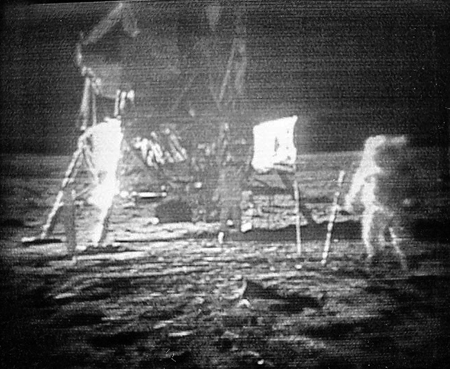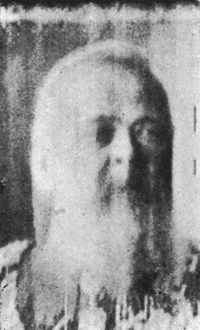

As the 20th Century dawned attempts were made to send photographs by wire. This 1906 portrait of the Prince Regent of Bavaria was scanned and sent through wire by Alfred Korn of Munich. Korn's progress in light sensitive electronic detectors helped pave the way for still and later moving images to be wired and broadcast.
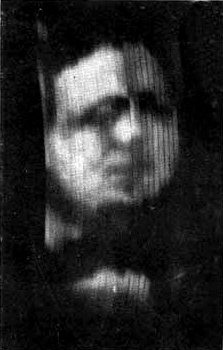
The word 'Television' was coined by the Russian
lecturer Constantin Perskyi on August 15, 1900 at the Paris International
Worlds Fair.
In 1925 Scotsman John Logie Baird first demonstrated live Television, at first with his ingenious mechanical scanning method using a spinning perforated disk invented by Paul Nipkow, who filed his earliest related patents in 1885. The first thing seen with Baird's 30 line 5 Frame Per Second vertical format vodeo was the head of a Ventriloquist dummy. This earliest surviving image of that first video format is from 1926.
Baird was as much a pioneer of Television as anyone, accomplishing
one breakthrough after another. By 1928 with better equipment
he demonstrated color and stereo prototypes. He made the first
trans Atlantic TV broadcast in 1928 and the first BBC TV broadcast,
as well as the first projection TVs which played live sporting
events to theater audiences. The decline of this initial system
was driven by the large spinning disk needed for a small screen
and the need for film to scan from in delayed shows. The big nail
in the coffin was the destruction of his lab in the 1936 Crystal
Palace fire.
A method was found to record such programs on 78 RPM records, the earliest surviving example being from November 24, 1927.
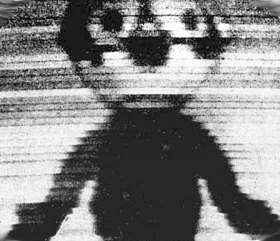
Electronic Television using a manipulated electron beam to scan a phosphor surface was a conceptual breakthrough pioneered by Utah inventor Philo T. Farnsworth who in 1926 demonstrated the first live action video by that method. That first sight was of a rotating glass slide with an opaque strip painted on it placed over a light table. A whiff of cigarette smoke was said to be the first image seen by a studio camera setup. A 1929 photo of a TV image of a statuette of Felix the Cat is probably the earliest surviving Electronic Television image. This is the basic method which was to improve over time over the 20th Century.
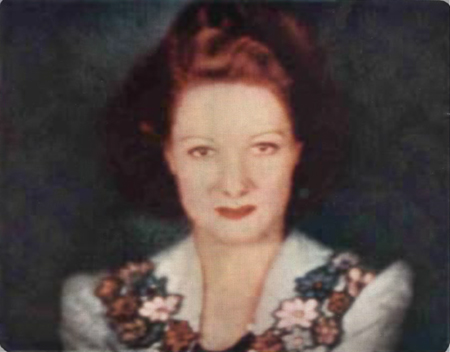
Far from retiring as TV technology out stepped his early efforts, John Logie Baird went on to demonstrate color Television. This 1941 still image from color video of British Aviator Miss Paddy Naismith suggests the advancing techology.
Television in the United States first made its big debut with a 343 line telecast of the opening ceremonies of the 1939 New York Worlds Fair, shown on a few receivers in New York. At this fair Franklin D. Roosevelt became the first President to appear on broadcast Television.
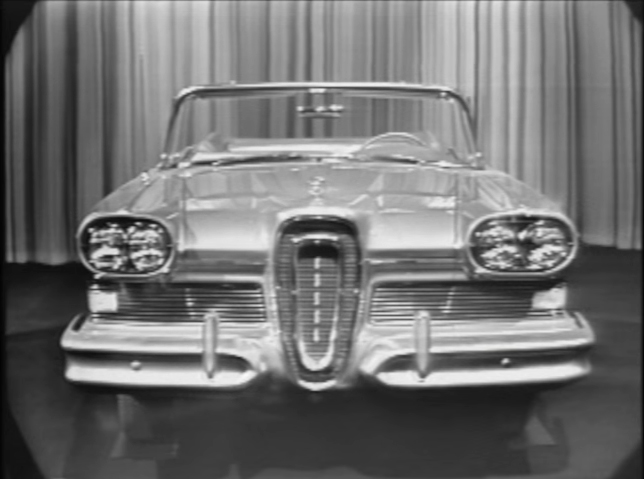
The TV video standard which was to reign supreme in the US for over half a century was defined in 1941 by the National Television Standards Committee (NTSC) as a 525 line 30 frame per second (interlaced 60 'half frames' per second) format. By the end of the 1940s television sets began to be common in homes.
The image was however ephemeral, there and gone. To record programs an optimized movie camera setup was initially used to film a TV monitor. An electronic recording method of capturing the video itself was sought. By 1957 a video tape machine was being sold by Ampex, using large reels of tape two inches wide. This image is from the earliest surviving videotape, of 'The Edsel Show' from October 13, 1957.
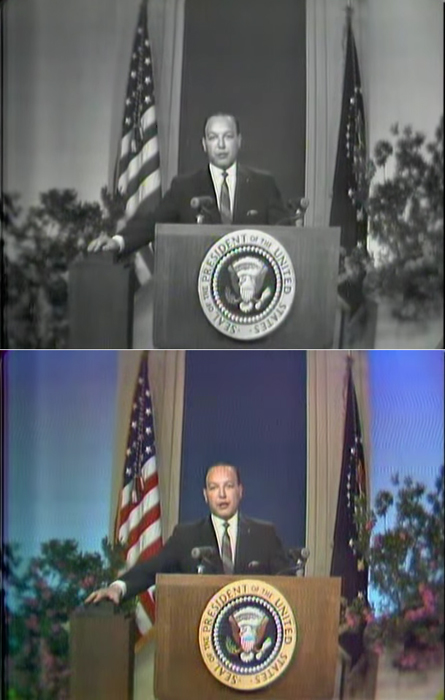
Color video in the United States had a rocky
road to realization. CBS attempted to leapfrog over the current
technology in its high quality RGB color television standard,
but RCA President David Sarnoff insisted any new color system
had to be compatible with the by then millions of existing black
and white television sets. He then intervened against an initial
approval of the CBS color system by the FCC. An RCA influenced
backwards compatible, but less capable, color television standard
was then adopted on December 23, 1953.
The technology of video taping swiftly followed up its black and
white capability with color. These two scenes are from the earliest
surviving color videotape, recorded May 22, 1958,. This shows
the moment our legacy of Television graduated from a black and
white to a color medium. Robert W. Sarnoff says: "By pressing
this button, which I now do" - then a brief tone as the signal
switches to color- "The cameras are transmitting a live color
picture". Afterwards President Eisenhower dedicated the new
WRC-TV color Television studios with a speech from that podium.
NTSC Video with its 30 frame per second image
has a greater time, or 'temporal' resolution than 24 frame per
second film. Despite the lower image resolution and color quality,
such video often provides a sense of 'presence' in a well preserved
recording that gives an impression it could have been made last
week. European TV standards settled on greater resolution but
with frame rates close to film, which gives impressive detail
in low movement scenes.
Any 'first images' of HDTV formats are elusive to my initial searches.
Briefly, HD was long sought after and was gradually crept toward
in various countries since the development of Television. In 1964
NHK in Japan began a research and development program for High
Definition Television, which had demonstrations of 1125 line video
sequences in 1972. By 1979 'Hi-Vision' television sets were being
sold in Japan. Later developments in Television and digital technology
culminated with the current HD standard of 1920 by 1080 pixels.
The first live telecast of moving images from the Moon took place during Apollo 11 on July 20, 1969. One of the first tasks of Armstrong and Aldrin on the Moon was to set up the black and white Television camera. Later Lunar missions steadily improved the image quality and were broadcast in color. Video sequences have since been made from ascendiing rockets and from orbit. Low light color video has also advanced to the degree color dim light phenomena can be recorded.
